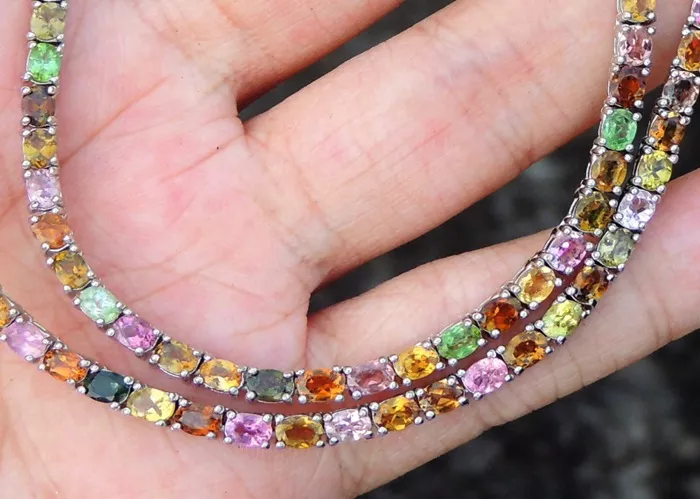Multicolored tourmaline is one of the most captivating and versatile gemstones in the jewelry world. Known for its rich variety of colors and unique crystal structure, this gem has attracted gemologists, jewelers, and collectors for centuries. Unlike many gemstones that come in a single color, multicolored tourmaline can display several colors in a single stone or come in many individual hues, making it highly prized for artistic and custom jewelry designs.
Tourmaline belongs to a complex group of boron silicate minerals. It is found in many parts of the world and occurs in a spectrum of colors ranging from deep blues and greens to vibrant pinks, reds, yellows, and even bi-color or tri-color stones. The diversity in color is due to the presence of various trace elements within the crystal structure.
The Nature of Multicolored Tourmaline
Tourmaline is a complex boron silicate mineral that contains elements like aluminum, iron, magnesium, sodium, lithium, or potassium. These variations give tourmaline its broad color spectrum. Multicolored tourmalines typically show colors such as pink, green, blue, yellow, and sometimes even red or purple in the same stone.
The gemstone’s colors appear in bands or zones, which can be sharp or softly blended. This zoning happens during the crystal’s growth, influenced by changes in temperature and the chemical environment. One famous variety is the watermelon tourmaline, which shows pink or red centers surrounded by green rims, resembling a watermelon slice.
Historical Origin and Discovery
Tourmaline’s history dates back thousands of years. Ancient cultures treasured the stone for its unique properties. The name “tourmaline” itself originates from the Sinhalese word “turmali” or “toramalli,” meaning “mixed colored stones.” This reflects the gemstone’s ability to display multiple colors.
Early traders from Sri Lanka and India introduced tourmaline to Europe in the 1500s. However, it was often confused with other gems such as emeralds and rubies because of its wide color range. The gemstone gained widespread recognition in the 19th century when mines in Brazil and Africa began producing large quantities of tourmaline, including the highly sought-after multicolored varieties.
Meaning and Symbolism of Multicolored Tourmaline
Tourmaline is more than just a pretty stone; it carries deep meanings and symbolism. Traditionally, tourmaline is believed to balance energy and protect against negative forces. The multicolored varieties symbolize diversity, acceptance, and unity. Each color within the tourmaline spectrum has its own significance:
- Pink and Red Tourmaline represent love, compassion, and emotional healing.
- Green Tourmaline is linked to growth, vitality, and prosperity.
- Blue Tourmaline is associated with calmness, communication, and clarity.
- Yellow and Golden Tourmaline embody creativity and confidence.
Wearing multicolored tourmaline is thought to harmonize the wearer’s energy and promote emotional well-being, making it a favored choice in spiritual jewelry.
Unique Qualities of Multicolored Tourmaline
Multicolored tourmaline stands out for several unique qualities:
1. Pleochroism
Tourmaline is strongly pleochroic, meaning it can show different colors when viewed from different angles. This optical phenomenon adds to the gem’s allure and makes each stone unique.
2. Color Zoning and Watermelon Tourmaline
One of the most famous multicolored tourmalines is the “watermelon” variety, which displays a pink or red core surrounded by a green outer layer, resembling a slice of watermelon. This natural color zoning is rare and highly prized.
3. Hardness and Durability
Tourmaline ranks 7 to 7.5 on the Mohs scale, making it durable enough for everyday jewelry use. Its toughness allows it to withstand wear without easily scratching or breaking.
4. Variety of Cuts and Settings
Because of its crystal form and optical properties, tourmaline can be cut into a wide range of shapes — from emerald cuts to rounds and fancy shapes — enhancing its natural beauty.
Sources and Mining Locations
Multicolored tourmaline is mined worldwide, with key sources including Brazil, Nigeria, Madagascar, Afghanistan, and the United States (California and Maine). Brazilian mines produce some of the most vibrant and diverse colors, while African deposits offer unique varieties like Paraíba tourmaline, known for its electric blue and green hues.
Uses in Jewelry Design
Jewelry designers prize multicolored tourmaline for its versatility and beauty.
It is commonly used in:
- Rings
- Earrings
- Necklaces
- Bracelets
- Statement pieces
Designers often highlight the color contrasts within the stone or combine several stones to create colorful, eye-catching designs. The gem’s durability makes it ideal for both everyday wear and special occasions.
Multicolored Tourmaline Care and Maintenance
Multicolored tourmaline is a stunning gemstone known for its vibrant hues and durability (7–7.5 on the Mohs scale). However, proper care is essential to maintain its brilliance.
- Cleaning: Use warm, soapy water and a soft brush to gently clean tourmaline. Avoid harsh chemicals, ultrasonic cleaners, and steam cleaning, as sudden temperature changes or chemicals can damage the stone.
- Storage: Store tourmaline separately from harder gems like diamonds to prevent scratches. A soft pouch or lined jewelry box is ideal.
- Wear & Handling: Remove tourmaline jewelry during physical activities, as impacts can cause chips or fractures. Avoid prolonged exposure to sunlight, which may fade some colors.
- Recharging: Some believe tourmaline benefits from occasional rinsing under running water to cleanse negative energy, though this is optional.
With proper care, multicolored tourmaline can remain a dazzling and long-lasting treasure in your collection.
Conclusion
Multicolored tourmaline is a gemstone full of character and beauty. Its diverse colors, rich history, and symbolic meanings make it a favorite among jewelry enthusiasts and designers alike. Whether used in simple settings or bold, artistic creations, multicolored tourmaline continues to captivate with its natural charm and elegance.
Related topics:
- Elbaite: The Stunning Gemstone of Colors and Symbolism
- Paraiba Tourmaline: The Rarest Gemstone with Neon Beauty
- Michael M Jewelry Maintains Prices Despite Tariff Challenges


